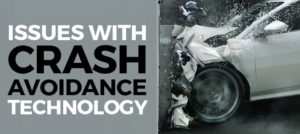 Auto manufacturers are constantly trying to come up with new systems and features to offer in their models to attract customers. Due to an increased concern about vehicle safety over the past couple of decades, manufacturers have specifically looked for ways to both protect motorists in the event of a crash and to try to prevent crashes from happening in the first place. One feature commonly offered on cars and SUVs is crash avoidance technology.
Auto manufacturers are constantly trying to come up with new systems and features to offer in their models to attract customers. Due to an increased concern about vehicle safety over the past couple of decades, manufacturers have specifically looked for ways to both protect motorists in the event of a crash and to try to prevent crashes from happening in the first place. One feature commonly offered on cars and SUVs is crash avoidance technology.
There are many different types of crash avoidance technologies offered on different types of vehicles. For example, the following are some features a vehicle may have:
- Electronic stability control – This older system detects when a driver has lost steering control due to skidding or other loss of traction. The system then automatically reduces engine power and/or applies individual brakes in a manner that allows a driver to regain control
- Collision warning systems – These systems use laser, camera, or radar sensors to determine if a moving vehicle is coming too close to another vehicle or object and then warns the driver of an imminent crash so the driver and apply the brakes or steer to avoid the collision.
- Automatic emergency braking and/or steering systems – If these systems detect an imminent collision, the vehicle autonomously applies the brakes or steers the vehicle out of the path of the danger. Generally, braking will occur at lower speeds and steering will occur at higher speeds.
Though these systems do not always completely prevent a front collision, in many situations, a resulting impact may be much less severe than if the driver had no warning or assistance at all. Other examples of crash prevention systems include warnings when a driver is about to back over something, warnings when speed is too high on a curve, warnings when a driver is departing their lane, and systems that detect vehicles or objects in a driver’s blind spot.
Effectiveness Of Crash Avoidance Systems
The Department of Transportation (DOT) and the Insurance Institute for Highway Safety (IIHS) have touted the general effectiveness of these systems in avoiding crashes. For example, IIHS research showed that electronic stability control technology can reduce the risk of rollover accidents by up to 80 percent and the risk of fatal accidents by over 30 percent. [1] Some front crash prevention systems were found to reduce insurance claims for bodily injury by approximately 29 percent. [2]
These crash avoidance technologies are often only included in the more expensive models an auto manufacturer may offer. However, because of the largely successful results of these systems thus far, ten different auto manufacturers have recently pledged [3] to begin including automatic emergency braking technology as standard on every new vehicle they build. These manufacturers include:
- Audi
- Ford
- Mazda
- Toyota
- Volvo
- BMW
- General Motors
- Mercedes-Benz
- Tesla
- Volkswagon
You Cannot Always Rely On Crash Avoidance Systems
Though these systems do protect motorists from accidents and resulting injuries, they are not infallible. If fact, the following are some things of which motorists using these systems should be aware:
- Systems can malfunction – Like any other part of a motor vehicle, these systems can be defective and may malfunction. If a driver is relying on this technology to avoid a crash and is used to the warning system, they may not be paying as close of attention to the road. If they come upon a vehicle or obstacle and do not hear a warning due to a malfunction, they may react less instinctively than they normally would because they are used to the warnings. Additionally, if these systems malfunction and apply the brakes or steer the vehicle when it is not necessary to avoid a crash, it could even cause a collision.
- Weather conditions can affect performance – Sensors that detect a potential crash may not work in any type of adverse weather condition such as rain, snow, sleet, or fog. Since these types of weather conditions often increase the risk of crashes in the first place, the failure of this technology can lead to serious crashes and injuries.
- These systems cannot compensate for driver negligence – No matter how effective a crash avoidance system may be, it cannot prevent accidents that are caused by other negligent drivers, so motorists should always be vigilant when on the roads.
Contact An Experienced Philadelphia Auto Accident Attorney Today
If you have been in a crash due to failed equipment, a negligent driver, or any other reason, please do not hesitate to call a qualified car accident lawyer at The Levin Firm Personal Injury Lawyers at 215-825-5183 for a free consultation today.
- http://www.iihs.org/iihs/news/desktopnews/electronic-stability-control-could-prevent-nearly-one-third-of-all-fatal-crashes-and-reduce-rollover-risk-by-as-much-as-80-effect-is-found-on-single-and-multiple-vehicle-crashes
- http://www.iihs.org/iihs/sr/statusreport/article/50/7/2
- http://www.iihs.org/iihs/news/desktopnews/u-s-dot-and-iihs-announce-historic-commitment-from-10-automakers-to-include-automatic-emergency-braking-on-all-new-vehicles